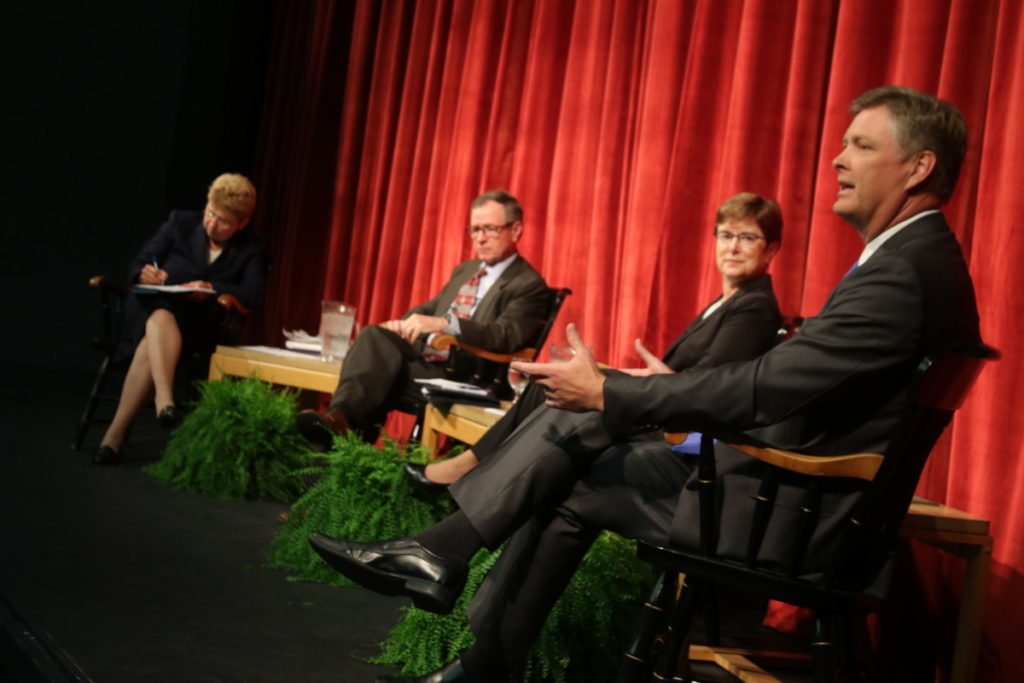Nurses, As Much As Tech,
Key To Healthcare Future

By LIBBY CUDMORE • Special to www.ALLOTSEGO.com
ONEONTA – What may have felt like a major technological innovation may have been a misstep.
“Ten years ago, we put computers in every room, thinking it would speed up paperwork,” said Jeff Joyner, Fox Hospital president. “But what I see now is nurses with their backs to their patients. We’ve lost that human touch, and we need to figure out how to balance it, because we are going to be seeing people on their best days and on their worst.”
Joyner, alongside Mark Webster, Cortland Regional Medical Center president & CEO, and Betsy Tanner Wright President, UPMC Chautauqua WCA Healthcare in Jamestown, and herself a Hartwick College graduate, on “Nurses’ Role In the Future of Healthcare: A CEO’s Perspective,” part of the Hartwick College Nursing Symposium.
“Generation Z is always on their phone,” he said. “I went on some rounds at St. George, and all the nurses had their iPads out while they were sitting with their patients. We need to break that and encourage them to get to know their patients.”
“They’ve done studies, and their brains are wired differently because of the technology,” said Hartwick College President Margaret Drugovich, who moderated the discussion. “Can you imagine how that might be an advantage?”
“We don’t want technology to be a barrier,” said Wright. “But I believe this generation will be able to seamlessly adapt to the technology, so they will have more time to interact with the patients.”
“When someone comes into the doctor, they always say three things,” said Webster. “Don’t hurt me, make me better and be nice to me. If we have our backs to them to work on a computer, we’re not being nice. How does technology interface with the patient care?”
However, Webster said that telemedicine can increase a nurse’s ability to interact with patients in rural areas. “A nurse serving patients in a rural area might drive all day and see four patients,” he said. “But if we can put a device into a patient’s home, where they can interact with a nurse for 15 minutes a day, that nurse can see 15 patients an hour. And if they do need to dispatch someone, that nurse can send someone to that person’s house to check in on them.”
Webster also said that, looking ahead, it will be nurses, not doctors, who will drive patient-centered care. “Nursing is pivotal,” he said. “Physicians are becoming more of a one-off, artisan approach, whereas nurses have a high-reliability factor. Nurses drive things. There are three million nurses in this country, and they are essential to where we go next.”
And as such, Drugovich asked, are nurses confined to the bedside, or can they work alongside executives in making decisions for the hospital. “Nursing leadership is going to be critical going forward,” said Wright. “We have come so far in nursing leadership. I really believe the role is changing, and we have a role, as healthcare leaders, to support that.”
All three hospitals have nurses on their boards, and at Fox Hospital, Jeanne-Marie Havener, was a nurse and was the former chair of the Hartwick College nursing department.
“Can a nurse ever be a hospital president?” asked Drugovich.
“Yes!” said Joyner.
Wright and Webster agreed.
“You have an opportunity to impact patient care, whether you’re at the bedside or in the boardroom,” said Wright.


Great article.